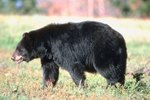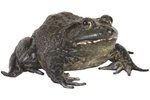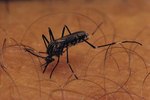Hibernation is a dormant state that some animals enter seasonally. During hibernation, animals do not eat. They drink very little and spend most of their time physically inert. True hibernation is only done by warm-blooded animals during cold weather when food is also scarce. However, in common usage all types of seasonal animal dormancy are usually called "hibernation."
The technical terms for different types of dormancy are diapause, a genetically determined seasonal suspension of physical development performed by invertebrates and some mammals during cold weather; brumation, seasonal cold-weather dormancy of some cold-blooded vertebrates; and estivation, dormancy during hot, dry weather performed by some invertebrates and cold-blooded vertebrates.
Hibernating Mammal Pets
Hamsters, duprasi or fat-tailed gerbils, deer mice, prairie dogs and skunks can fall into a brief, hibernation-like state called torpor if they are exposed to cooling temperatures and shortening daylight. Hamsters also can estivate in hot weather. Hedgehogs hibernate and estivate. These states protect wild animals from environmental extremes, but allowing your pet to enter them can be deadly.
Torpor, estivation and hibernation in captive mammals are signs that something in the animal's environment is causing stress. Pet owners are advised to prevent such stress by keeping all mammal pets at normal room temperature and providing fresh food and clean water daily.
There are three species of dwarf fat-tailed lemur who hibernate. It is ill-advised to keep any primate as a pet. Most states ban such pets or have strict regulations and require a permit to keep them in captivity. Lemurs are critically endangered. It is illegal to import them into the U.S. for the pet trade and to transport them across state lines.
Pet Reptile Brumation
Reptiles are an extremely diverse group. Each species has specialized needs. It is not possible to make a statement that applies to all reptiles as behavior varies strongly between as well as within species. However, most reptile pets kept indoors at normal room temperatures or under heat lamps, with consistent periods of daylight, will not hibernate.
Warnings
- Consult a veterinarian who has experience with your pet's species before attempting hibernation.
- Hibernation is unnecessary for most indoor snakes, turtles and tortoises unless you plan to breed them.
- Only species from temperate climates brumate.
- Never attempt to hibernate a species from a tropical climate.
- Consult a veterinarian who has experience with your pet's species before attempting hibernation.
Occasionally, a pet snake will insist on hibernating regardless of what you do. This is most common for kingsnakes and their close relatives, milk snakes. A snake who wants to hibernate usually will refuse food and act agitated for an extended period of time in the late fall. If you must allow your snake to brumate, move her enclosure to a secure location where temperatures are below 60 degrees Fahrenheit but above freezing and light levels are low. Provide a hiding place and clean water but do not offer food. Most snakes will brumate for about 12 weeks and should be gradually warmed and exposed to increasing daylight over a period of several days before feeding.
Warnings
Any snake who appears to be ill or shedding should be removed from hibernation. Do not allow a snake to freeze. Pneumonia and other respiratory infections are common killers of hibernating snakes. Never allow an ill or underweight animal to hibernate.
Pet turtles and tortoises kept outdoors in mild climates usually brumate as needed without intervention. They become dormant and emerge again as temperatures and daylight dictate.
Other Exotic Pets
Some species of frog, fish and arthropod brumate, estivate or enter torpor in the wild based on environmental conditions. Most kept in captivity at steady temperatures, consistent daylight and with a regular supply of appropriate food and clean water do not need to and will not try to enter dormancy. If you think there is a compelling reason to hibernate one of these animals (such as for breeding) or if your pet's attempts to hibernate are persistent, consult an experienced veterinarian or husbandry association for instructions. Never attempt to force an animal to hibernate or assume that's what she's doing without seeking expert advice.
Warnings
Do not try to help an exotic pet hibernate if you don't know its species and its particular needs. Hibernation is unnecessary for most captive animals and attempts to do so may be a sign of illness or poor living conditions.
Writer Bio
Angela Libal began writing professionally in 2005. She has published several books, specializing in zoology and animal husbandry. Libal holds a degree in behavioral science: animal science from Moorpark College, a Bachelor of Arts from Sarah Lawrence College and is a graduate student in cryptozoology.





